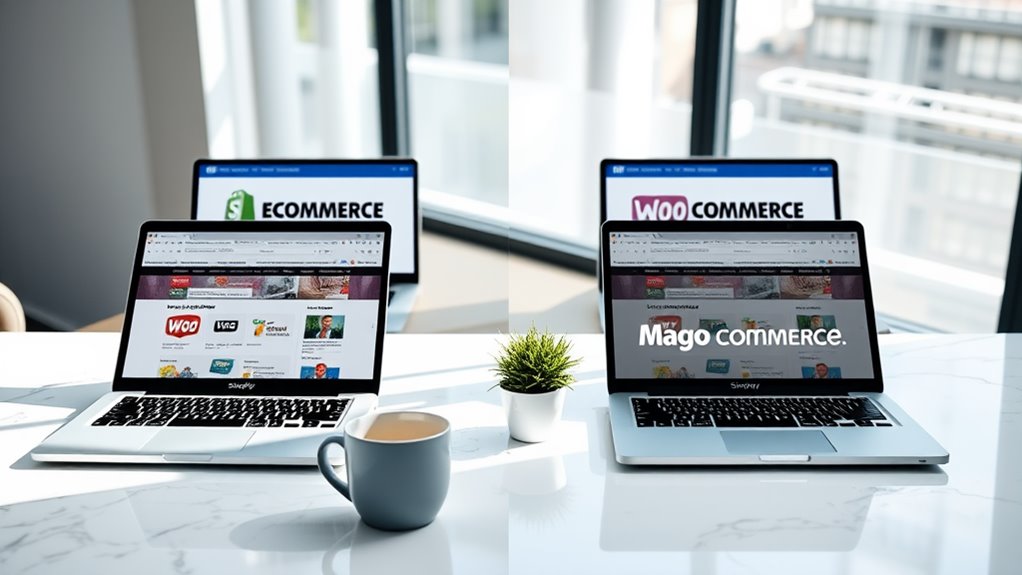Web design and development costs typically range from $1,000 to $75,000+, depending on your website's complexity and features. You'll find basic 1-5 page websites with standard contact forms start at $1,000-$5,000, while intermediate sites with CMS integration and basic e-commerce run $5,000-$15,000. Advanced websites featuring full e-commerce capabilities, custom APIs, and extensive functionality can exceed $15,000. Core development team costs average $75-200 per hour, with ongoing maintenance running 15-20% of your initial investment annually. The final price depends on your specific needs, chosen features, and development approach, making it essential to understand each cost factor before starting your project.
Key Takeaway
- Basic websites (1-5 pages) cost $1,000-$5,000, while advanced websites (15+ pages) with full e-commerce capabilities range from $15,000-$75,000+.
- Professional website design services typically cost between $2,000-$15,000, including custom graphics, typography, and brand consistency elements.
- Development team costs vary by role, with developers charging $75-200 per hour depending on expertise and location.
- Annual maintenance costs typically amount to 15-20% of the initial development budget, covering updates, security, and technical support.
- Third-party integrations like payment gateways, CRM systems, and custom plugins add extra costs to the overall website budget.
Website Complexity Levels
Different websites require vastly different levels of complexity, ranging from basic single-page designs to intricate e-commerce platforms. You'll find that understanding these complexity levels will help you budget appropriately and set realistic expectations for your project.
Basic Level
- Simple 1-5 page informational websites
- Standard contact forms and basic SEO
- Minimal interactive elements
- Template-based designs with basic customization
- Typical cost range: $1,000-$5,000
Intermediate Level
- 5-15 pages with custom functionality
- Content Management System (CMS) integration
- Basic e-commerce capabilities (up to 100 products)
- Custom design elements and animations
- Typical cost range: $5,000-$15,000
Advanced Level
- 15+ pages with complex functionality
- Full e-commerce solutions (500+ products)
- Custom API integrations
- Advanced security features
- Mobile app synchronization
- Typical cost range: $15,000-$75,000+
You'll need to evaluate factors like user authentication, payment processing, and database complexity when determining your website's level. Each additional feature you require will move your project higher within these complexity tiers and affect the final cost accordingly.
Core Features and Functionality
Essential Core Features:
- Responsive design for mobile, tablet, and desktop viewing
- Navigation menu and site architecture
- Content management system (CMS) integration
- Contact forms and user input capabilities
- Search functionality
- Basic SEO optimization
- Security features and SSL certification
- Analytics tracking
Advanced Functionality Options:
- E-commerce capabilities with payment processing
- User account management
- Database integration
- API connections
- Custom animations and interactive elements
- Multi-language support
- Advanced search filters
- Social media integration
You'll find that each feature you add will impact your overall cost, with basic features typically ranging from $1,000-3,000 and advanced features starting at $2,500 each. To maximize your budget, start by prioritizing features that directly support your business objectives and user needs. You can always scale up functionality as your website grows and evolves.
Design Elements and Branding

Professional design and branding elements greatly impact your website's cost while shaping its visual identity and user experience. You'll typically invest between $2,000 to $15,000 for thorough design services, depending on your brand's complexity and specific requirements.
Core design elements that influence your website's cost include:
- Custom graphics and illustrations, which range from $500-$2,000 per set and help establish your unique visual identity
- Typography selections, including premium font licenses that can cost $200-$500 annually
- Color palette development and implementation across your site, typically requiring 10-15 hours of professional design time
- Logo design or adaptation for web use, ranging from $750-$3,000 for professional creation
Your branding package often requires additional elements like icon sets, photo treatments, and design systems that guarantee consistency across your digital presence. You'll need to factor in the cost of style guide development, which typically ranges from $1,500-$5,000, depending on complexity. Remember that investing in professional design isn't just about aesthetics—it's about creating a cohesive brand experience that builds trust with your audience and distinguishes you from competitors.
Development Team Cost Factors
Building on your investment in design, the development team's composition and expertise represent a major portion of your website's budget. You'll need to take into account several key roles that impact your overall costs.
Core Development Team Roles and Costs:
- Front-end Developer ($75-150/hour): Transforms your design into interactive interfaces
- Back-end Developer ($85-175/hour): Creates server-side functionality and database architecture
- Full-stack Developer ($90-200/hour): Handles both front and back-end development
- Project Manager ($80-150/hour): Coordinates team efforts and timeline adherence
Additional Cost Factors:
- Team size and project duration
- Geographic location of developers (US-based vs. offshore)
- Level of expertise required
- Technology stack complexity
You'll find that larger projects typically require 3-5 team members working for 2-4 months, while smaller projects might need only 1-2 developers for 4-8 weeks. Your technology choices will also influence costs, as specialized frameworks like React or Angular often command premium rates. Keep in mind that US-based development teams typically cost 30-50% more than offshore alternatives, but often provide better communication and faster turnaround times.
Maintenance and Support Expenses

Ongoing website maintenance doesn't end when your site launches. Your website requires regular updates, security patches, and performance optimizations to stay competitive and secure in today's digital landscape. You'll need to budget for these recurring expenses, which typically range from $500 to $3,000 per month, depending on your site's complexity and requirements.
Consider these essential maintenance and support services you'll need to maintain your website's health:
- Regular security updates and vulnerability scanning, including SSL certificate renewal and malware protection ($100-400/month)
- Content management and updates, such as blog posts, product listings, and marketing materials ($200-800/month)
- Performance optimization and speed enhancements, including CDN management and caching setup ($150-600/month)
- Technical support and troubleshooting services, with response times ranging from 24-48 hours ($200-1,200/month)
You'll want to establish a maintenance contract with your development team or a dedicated support provider. This agreement should outline specific service levels, response times, and included services. Remember that investing in proper maintenance now can prevent costly emergency repairs and downtime later.
Platform and Technology Choices
Your website's foundation rests on the platform and technology stack you choose. The decisions you make at this stage will greatly impact both initial costs and long-term maintenance expenses, making it vital to select wisely.
Common Platform Options and Costs:
- WordPress: $3,000-$15,000 for custom development
- Shopify: $1,500-$10,000 for store setup
- Custom Solutions: $20,000-$100,000+ for enterprise-level development
Technology Considerations:
- Front-end frameworks (React, Angular, Vue.js)
- Back-end solutions (PHP, Node.js, Python)
- Database systems (MySQL, MongoDB, PostgreSQL)
You'll need to evaluate these factors when choosing your platform:
- Scalability requirements
- Integration capabilities
- Security needs
- Performance expectations
- Budget constraints
Each technology choice carries its own cost implications. For instance, if you're building an e-commerce site, Shopify might cost less initially but include monthly fees, while a custom solution could have higher upfront costs but lower recurring expenses. Consider your business's growth trajectory when making these decisions, as switching platforms later can be remarkably more expensive than choosing the right solution from the start.
Hidden Costs to Consider

Beyond the obvious platform and development expenses, web projects often carry unexpected financial obligations that can catch business owners off guard. You'll need to account for various hidden costs that can greatly impact your project's overall budget and long-term sustainability.
When planning your web project, consider these often-overlooked expenses:
- Ongoing maintenance fees, including security updates, bug fixes, and performance optimization, which typically cost 15-20% of your initial development budget annually
- Third-party integrations and API subscriptions, such as payment gateways, CRM systems, or analytics tools, that may require monthly or annual licensing fees
- Content creation and management costs, including copywriting, image licensing, and regular content updates to keep your site fresh and engaging
- Legal and compliance requirements, such as privacy policy updates, GDPR compliance, and SSL certificate renewals
Conclusion
Your website's total cost will depend on your specific needs, but you'll typically invest between $3,000 and $75,000 for professional development. According to a recent WebFX study, 94% of first impressions are design-related, making it essential to allocate your budget wisely. Whether you're launching a simple portfolio site or a complex e-commerce platform, remember to factor in ongoing maintenance, hosting, and potential updates to protect your investment.









